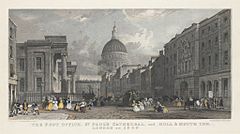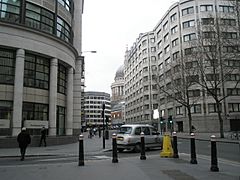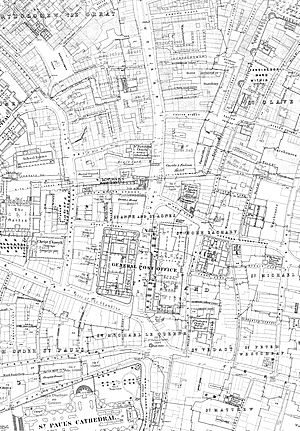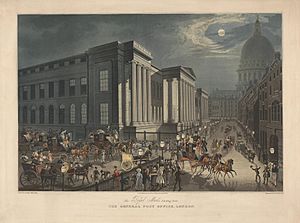St. Martin's Le Grand facts for kids
St. Martin's Le Grand is a famous street in the City of London. It's located north of Newgate Street and Cheapside, and south of Aldersgate Street. This street is also the very start of the A1 road, a major route in Britain. For many years, when people said "St. Martin's Le Grand," they were often talking about the main Post Office because its headquarters were there from 1829 to 1984.
Contents
A Special Church and College
To the east of St. Martin's Le Grand, a very old college and church once stood. This church was named after St Martin of Tours and had a group of priests called canons. It was located in the City of London area known as St Leonard, Foster Lane.
Some stories say the college and church were built as early as the 600s or 700s by King Wihtred of Kent. However, it's more certain that two brothers, Ingelric and Girard, rebuilt or founded it around 1056, during the time of Edward the Confessor. William the Conqueror officially approved its creation in 1068.
The church had an important job: it rang the curfew bell every evening. This bell told everyone that the city gates were closing for the night. The church also offered a special protection called "sanctuary." This meant that people who were in trouble could find safety there until 1697. Because of this, the area became a well-known hiding place for people who had broken the law.
In 1503, Westminster Abbey took over the college. This meant the Abbey could use the college's money to help pay for the Henry VII Chapel. It was an arrangement for money, not that the college became a monastery.
A Special Area: The Liberty
Because it was owned by a religious group, the college was closed down by King Henry VIII in 1548. The buildings were then torn down to make way for new developments.
However, because of its past connection to Westminster Abbey, this area was seen as a special "liberty." This meant it was outside the usual rules and laws of the City of London. People living there even voted in elections for the borough of Westminster until 1832. It was almost like a small piece of Middlesex county, even though it was in the middle of London!
This special status changed in 1815 when a new law connected the liberty to the Aldersgate area of the City of London. This was done because the site was chosen for a brand new General Post Office.
The Main Post Office Building
The General Post Office (GPO) built its main national office on the site of the old college after the 1815 law. Construction of the General Post Office building started in 1825. It was designed in a grand, classic style by Robert Smirke and opened in 1829.
This building was home to the Postmaster General (the head of the Post Office) and other important staff. It also served as London's main place for sorting mail and as a public post office. In the early days, before trains took over, mail coaches would leave from here to deliver mail all over the country. The coaches and horses would get ready at the Bull and Mouth Inn, which was right across the street. Coaches heading north would go up St. Martin's Le Grand through Aldersgate. This became the very first part of the Great North Road (now the A1 route) that goes all the way to York and Edinburgh.
Later in the 1800s, the GPO built more offices on the west side of St. Martin's Le Grand. These were for telegraph workers (built in 1874) and for headquarters staff (built in 1894). The original General Post Office building was used until 1911. Then, it was torn down and replaced by new buildings to the west. The main Post Office headquarters stayed on St. Martin's Le Grand until 1984. The BT Centre, built in the same year, was the main office for BT Group until 2021. BT Group started from the Post Office's phone division in 1981.
Early Wireless Technology
Did you know that Guglielmo Marconi, who invented wireless telegraphy, did an important experiment here? On July 27, 1896, he and his helper, George Kemp, successfully showed how their wireless telegraphy system worked between two Post Office buildings. They put a transmitter on the roof of the Central Telegraph Office on St. Martin's Le Grand. The receiver was on the roof of the General Post Office South on Carter Lane. The two buildings were about 300 meters (or yards) apart. Later that year, the Post Office even gave Marconi money to do more experiments! There's a special plaque at the transmitter site (which is now the BT Centre) to remember this important event.
French Protestant Chapel
A French Protestant chapel stood on the west side of the street, at the corner of Bull and Mouth Street. It was there from 1842 until 1888. It was then taken down to make room for new and bigger Post Office buildings.
Getting Around: Transport Links
The closest London Underground station is St Paul's. It was originally called "Post Office" and is located at the southern end of the street.






